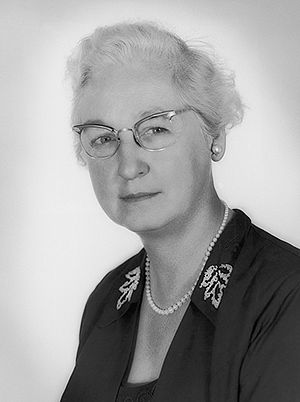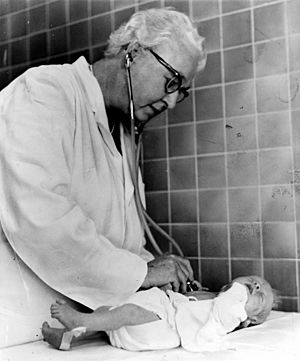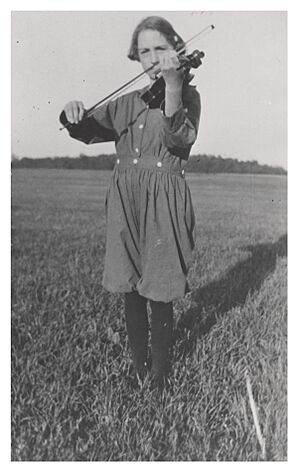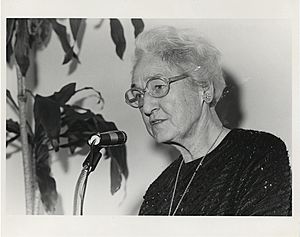Virginia Apgar facts for kids
Quick facts for kids
Dr.
Virginia Apgar
MD
|
|
|---|---|

Virginia Apgar (July 6, 1959)
|
|
| Born | June 7, 1909 Westfield, New Jersey, U.S.
|
| Died | August 7, 1974 (aged 65) Manhattan, New York, U.S.
|
| Citizenship | American |
| Education | Mount Holyoke College Columbia University Johns Hopkins University |
| Occupation | Anesthesiologist |
| Years active | 1937–1974 |
| Known for | Inventor of the Apgar score |
| Medical career | |
| Profession | Doctor |
| Field | Anesthesiology, teratology |
| Sub-specialties | Obstetric anesthesiology |
| Notable works | Is My Baby All Right? A Guide to Birth Defects, with Joan Beck |
Virginia Apgar (June 7, 1909 – August 7, 1974) was an American doctor and medical researcher. She was a specialist in anesthesiology, which is the study of pain relief during surgery. She also focused on helping mothers and babies during childbirth.
Dr. Apgar is most famous for inventing the Apgar score. This is a quick way to check a newborn baby's health right after birth. She was a leader in her field and helped improve care for newborns.
Contents
Early Life and Education
Virginia Apgar was born and grew up in Westfield, New Jersey. Her father was a business executive and loved astronomy. He even helped uncover a spy ring during World War I with his amateur radio.
Virginia was the youngest of three children. Sadly, her older brother died young from tuberculosis. Her other brother also had a long-term illness.
Music was very important in her family. They often played music together. Virginia played the violin, and her brother played piano and organ. She loved her violin and often played in small music groups wherever she went.
She finished Westfield High School in 1925. Even then, she knew she wanted to become a doctor.
Virginia went to Mount Holyoke College and graduated in 1929. She studied zoology, which is the study of animals. She also studied physiology (how living things work) and chemistry. In 1933, she graduated from Columbia University College of Physicians and Surgeons (P&S). She was one of the top students in her class.
She then completed a surgery training program at P&S in 1937. However, the head of surgery, Allen Whipple, suggested she try a different path. He encouraged her to study anesthesiology instead of becoming a surgeon.
Virginia decided to follow his advice. She trained for six months with Ralph Waters at the University of Wisconsin–Madison. He had started the first anesthesiology department in the United States. She was the only woman among many men in his team.
She then trained for another six months at Bellevue Hospital in New York. In 1937, she became a certified anesthesiologist. She returned to P&S in 1938 to lead their new anesthesia division. Later, in 1959, she earned a master's degree in public health from Johns Hopkins School of Hygiene and Public Health.
Contributions to Medicine
Virginia Apgar was the first woman to lead a special medical division at NewYork–Presbyterian Hospital and Columbia University College of Physicians and Surgeons. She helped start the anesthesia division there. She was in charge of managing the division, hiring staff, and making sure their work ran smoothly. For much of the 1940s, she was a leader, teacher, and doctor.

In 1949, P&S created an official department for anesthesiology. Even though she was expected to lead it, the job went to a male colleague. Virginia Apgar was given a teaching position instead.
Focus on Obstetrics
In 1949, Dr. Apgar became the first woman to become a full professor at P&S. She stayed there until 1959. During this time, she also worked at the Sloane Hospital for Women, which is part of NewYork–Presbyterian Hospital.
In 1959, Dr. Apgar left Columbia and earned a Master of Public Health degree. From 1959 until her death in 1974, she worked for the March of Dimes Foundation. This organization focuses on preventing and treating birth defects. She was a vice president and led their research program.
In 1967, Dr. Apgar became vice president and director of basic research at the March of Dimes.
During the rubella outbreak of 1964–65, Dr. Apgar strongly supported getting everyone vaccinated. This was to stop rubella from passing from mothers to their babies. Rubella can cause serious birth defects if a pregnant woman gets infected. In New York City, about 1% of all babies born then were affected by rubella.
Dr. Apgar also taught pediatrics (the study of children's health) at Cornell University School of Medicine. She taught about teratology, which is the study of birth defects.
She continued to serve the National Foundation as Director of Basic Medical Research and vice-president for Medical Affairs. In 1973, she also became a lecturer in medical genetics at the Johns Hopkins School of Public Health.
The Apgar Score
In 1952, Dr. Apgar created the 10-point Apgar score. This score helps doctors and nurses quickly check how healthy a newborn baby is.
Each baby gets a score of 0, 1, or 2 for five different things:
- heart rate
- breathing
- skin color
- muscle tone
- reflexes (how they react to touch)
A score of 2 means the baby is in great condition, while 0 means they are having trouble. The total score for a baby can be anywhere from 0 to 10. A score of 10 is the best possible.
Doctors usually check the baby one minute after birth. If the baby's condition doesn't improve, they can check again every five minutes. By the 1960s, many hospitals in the United States were using the Apgar score. Today, it is still used worldwide to quickly understand a newborn's health right after birth.
Personal Life
Virginia Apgar never married or had children.
She passed away on August 7, 1974, at Columbia-Presbyterian Medical Center. She is buried in Fairview Cemetery in Westfield.
Interesting Facts About Virginia Apgar
- Dr. Apgar traveled thousands of miles every year. She spoke to many different groups about how important it was to find birth defects early. She also talked about the need for more research.
- She was a great ambassador for the National Foundation. The money the organization raised each year more than doubled while she worked there.
- In 1972, she wrote a book called Is My Baby All Right? with Joan Beck.
- She was the first person to hold a teaching position in the new field of pediatrics.
- Dr. Apgar published over sixty scientific articles and many shorter pieces for newspapers and magazines.
- In 1973, the Ladies Home Journal named her Woman of the Year in Science.
- Throughout her career, she believed that being a woman did not limit her medical career.
- Her hobbies included music. She was very good at playing the violin.
- In the 1950s, a friend taught her how to make musical instruments. Together, they made two violins, a viola, and a cello.
- She loved gardening and enjoyed fly-fishing, golfing, and stamp collecting.
- When she was in her fifties, Dr. Apgar started taking flying lessons. She once said her goal was to fly under New York's George Washington Bridge someday!
Legacy and Recognition
Virginia Apgar continues to be honored for her important work.
- In 1994, the United States Postal Service honored her with a 20¢ Great Americans series postage stamp.
- In November 1995, she was added to the National Women's Hall of Fame in Seneca Falls, New York.
- In 1999, she was recognized as a Women's History Month Honoree by the National Women's History Project.
- On June 7, 2018, Google celebrated Dr. Apgar's 109th birthday with a special Google Doodle.
Honors and Awards
- Honorary doctorate, Women's Medical College of Pennsylvania (1964)
- Honorary doctorate, Mount Holyoke College (1965)
- Distinguished Service Award from the American Society of Anesthesiologists (1966)
- Elizabeth Blackwell Award, from the American Women's Medical Association (1966)
- Honorary doctorate, New Jersey College of Medicine and Dentistry (1967)
- Alumni Gold Medal for Distinguished Achievement, Columbia University College of Physicians and Surgeons (1973)
- Ralph M. Waters Award, American Society of Anesthesiologists (1973)
- Woman of the Year in Science, Ladies Home Journal (1973)
- Fellow of the New York Academy of Medicine, the American Public Health Association, and the New York Academy of Sciences.
- Inductee into the New Jersey Hall of Fame (2020)
See Also
 In Spanish: Virginia Apgar para niños
In Spanish: Virginia Apgar para niños




